Gochujang and gochugaru substitutes can be tough to pick from. From finding the perfect flavor to picking from availability, there is a lot to mull over. Well, allow me to help you with the former. I’ll cover the best substitutes for gochujang that will cater to your every need.
You can substitute gochujang with Doenjang, sriracha, sambal oelek, tomato paste, and chili garlic sauce. But this isn’t all. I’ll cover a load more gochujang swaps, so let’s get right in!

Jump To
🤷 What is Gochujang?
Gochujang is a staple ingredient in Korean cuisine, known for its spicy, sweet, and umami flavor profile. It’s made from fermented soybeans, chili powder, glutinous rice, and salt. The mixture is then aged in earthenware pots, which gives it a distinct flavor and aroma. It can be used in stews, marinades, and dipping sauces for pork chops but is commonly used in dishes such as kimchi, bibimbap, tteokbokki, and bulgogi.
🧑🍳 How to Make Gochujang
To make gochujang, start by soaking glutinous rice overnight and cooking it until mushy. Simultaneously, soak soybeans and cook until tender, then blend both into a paste. Dissolve malt powder in water in a separate bowl and combine with the paste, allowing it to ferment. In another bowl, mix Korean red pepper powder with salt and add it to the fermented paste. Let the mixture ferment further, stirring daily, until it achieves the desired taste and consistency.
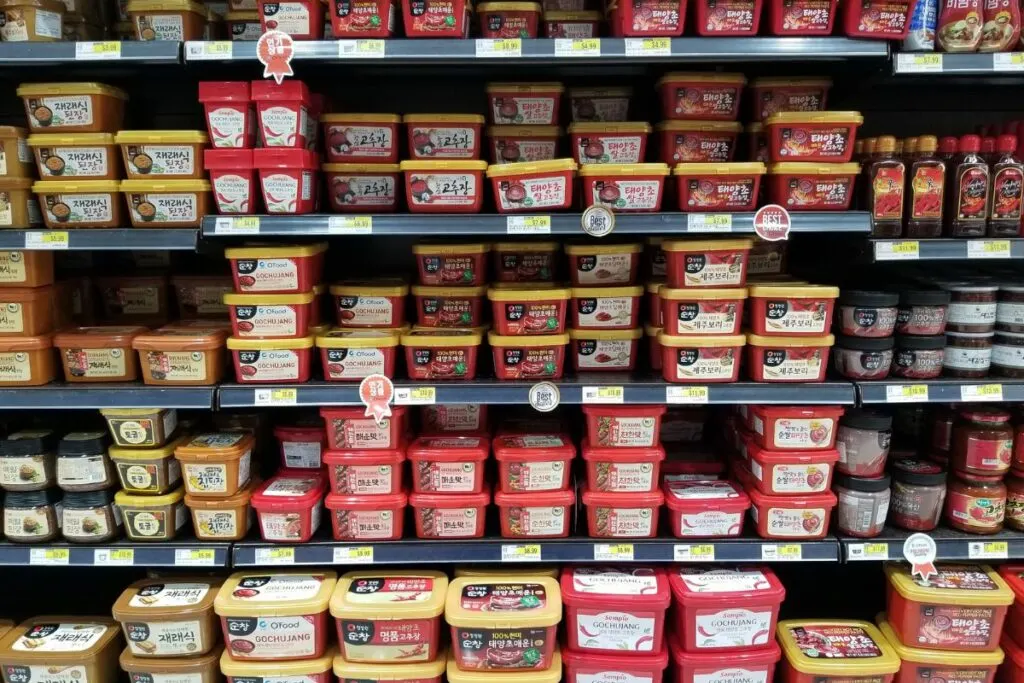
💡 Best Substitutes for Gochujang
DIY Miso-Based Sauce
Let’s start off with a quick DIY Miso sauce that uses miso paste. This sauce is a traditional Japanese ingredient made by fermenting soybeans, with a savory taste that’s quite similar to gochujang. To make a miso-based sauce, you’ll need:
- 1/4 cup of miso paste
- 1 tablespoon of soy sauce
- 1 tablespoon of rice vinegar
- 1 tablespoon of honey
- 1 teaspoon of sesame oil
- 1/4 teaspoon of garlic powder
Simply mix all of the ingredients together until it’s smooth and properly combined. You can also adjust the amount of honey and garlic powder to your taste preference.
Doenjang
1 teaspoon of gochujang = 1 teaspoon of doenjang and thin it with water
Doenjang is another key ingredient in Korean cuisine that’s made by combining soybeans, salt, and water, then allowing the mixture to ferment for several months. This combination results in a savory and slightly sweet flavor that’s similar to miso. This fermented soybean paste adds a perfect level of richness and composure to the overall flavor profile of any Korean dish. If you can’t find any, you can use doenjang substitutes instead.
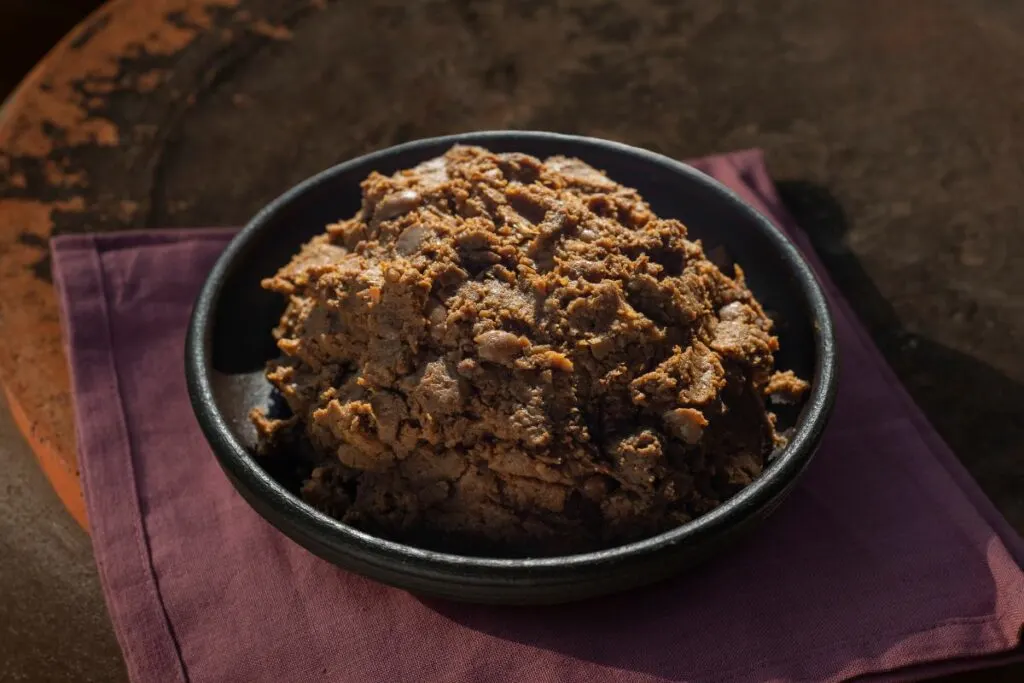
Ssamjang
1 teaspoon of gochujang = 1 teaspoon of ssamjang
Ssamjang is a thick Korean sauce made from a combination of doenjang (fermented soybean paste), garlic, sesame oil, and other ingredients. This sauce is typically used as a dipping sauce for Korean barbecue and packs a spicy and savory kick to many dishes.
Miso Paste
1 teaspoon of gochujang = 1 teaspoon of miso paste
Miso paste is a traditional Japanese ingredient made from fermented soybeans. It has a savory taste similar to gochujang and doenjang. It’s widely used in Japanese cuisine but can also be used in Korean dishes as a condiment. You can try using some miso paste substitutes if you want a more exact flavor or can’t find any.
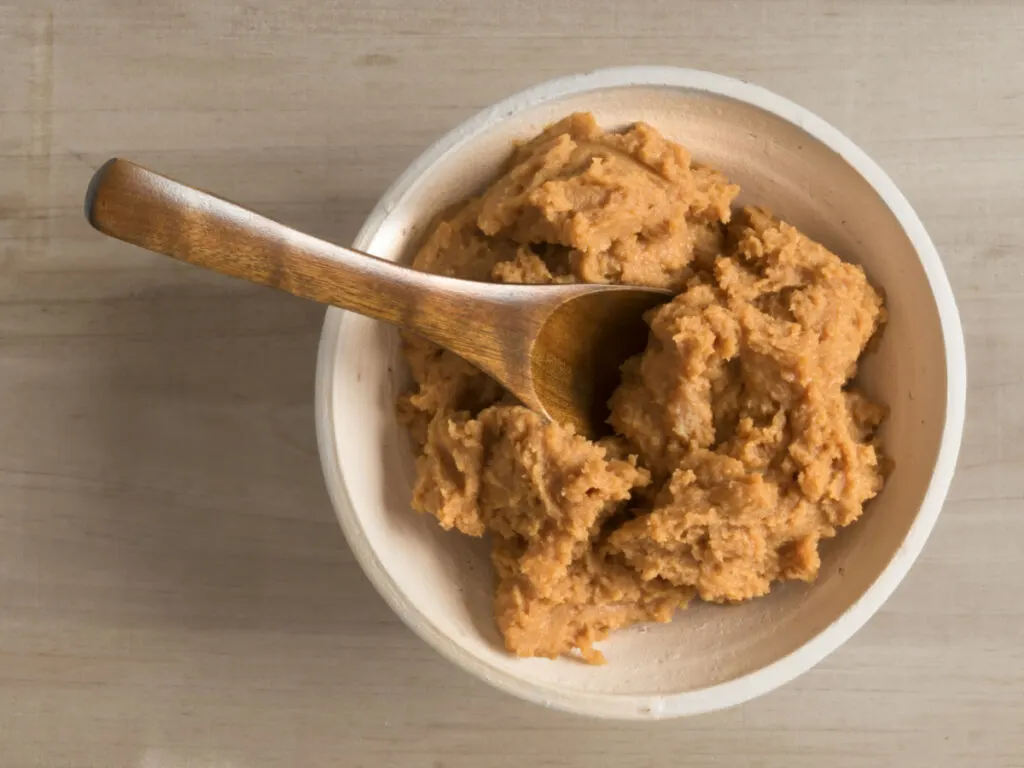
Sriracha
1 teaspoon of gochujang = 1 teaspoon of sriracha
Sriracha sauce can be a fantastic alternative for gochujang as it’s made from a blend of red chili peppers, vinegar, garlic, sugar, and salt, resulting in a spicy and slightly sweet taste. Although it’s used in Thai and Southeast Asian cuisine, it can also be used to deliver a unique flavor to many Korean dishes. Its blend of spiciness and sweetness is delicious, but if you can’t find any, you can use sriracha substitutes instead.
Sambal Oelek
1 teaspoon of gochujang = 1 teaspoon of sambal oelek
Sambal Oelek is a popular Indonesian chili paste that’s made from red chili peppers, vinegar, and salt. Its tasty, spicy, and slightly tangy flavor will be perfect as a substitute for gochujang. This paste is highly flexible in marinades, sauces, stir-fry dishes, and as a dipping condiment. You can also use some sambal oelek substitutes if you can’t find any or want a similar taste.
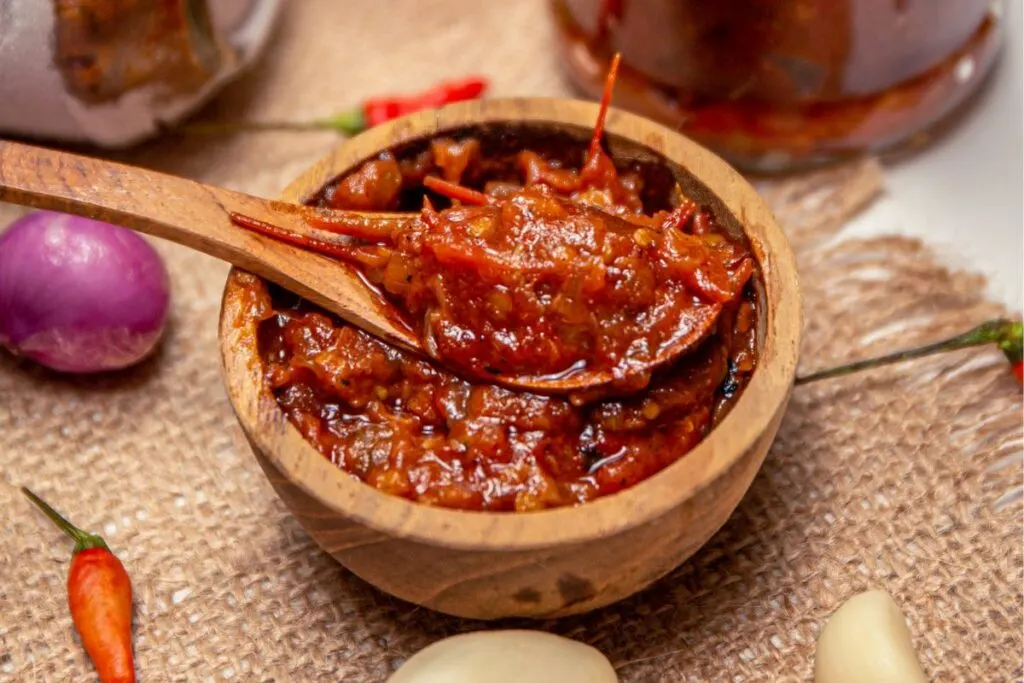
Tomato Paste
1 teaspoon of gochujang = 1 teaspoon of tomato paste
Tomato paste is the most common and easy-to-use substitute for gochujang on the list. Made from concentrated tomatoes cooked down and reduced to a thick paste, this paste packs a slightly sweet and tangy flavor that’s great for sauces, soups, stews, and marinades. It can also serve as a pizza sauce substitute base.
Red Pepper Flakes
1 teaspoon of gochujang = 1 teaspoon of red pepper flakes
Red pepper flakes are a spicy substitute made by drying and crushing red chili peppers to create a spicy and slightly smoky flavor. Their unique spiciness and smoky flavor make them a great alternative in a marinade, sauce, stir-fry ingredient, or dipping condiment. Though red pepper flakes don’t have the same consistency, they can still provide a similar flavor profile and add a delicious kick to many dishes.
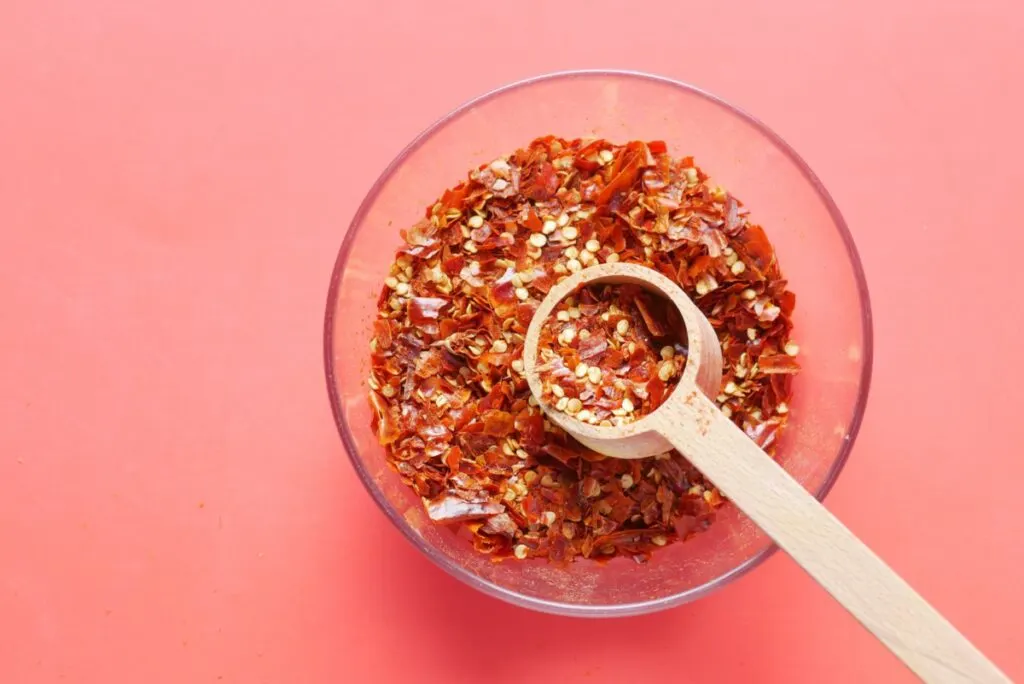
Thai Chili Paste
1 teaspoon of gochujang = 1/2 teaspoon of Thai chili paste
This paste comes in different varieties, but one of the most popular ones is nam prik pao, Thai roasted chili paste. It’s made by roasting chili peppers, shallots, garlic, and shrimp paste and blending them with sugar, tamarind paste, and fish sauce. This gives it a sweet, smoky, and spicy flavor that’s great for stir-fries, soups, and repurposing leftover curries. If you really want to tone down the heat, you can mix the paste with coconut milk or yogurt to create a milder version.
Chili Garlic Sauce
1 teaspoon of gochujang = 1 teaspoon of chili garlic sauce
Chili Garlic Sauce is a flavorful ingredient that can add a distinctive punch to any dish. Made from a blend of chili peppers, garlic, vinegar, and sugar, this sauce has a spicy and slightly sweet taste. Chili sauce and gochujang have a similar spicy flavor, but the chili garlic sauce has a thinner consistency. You’ll need to adjust the other ingredients in your recipe to compensate for this. If you want a more similar spice, you can use some chili garlic sauce substitutes instead.
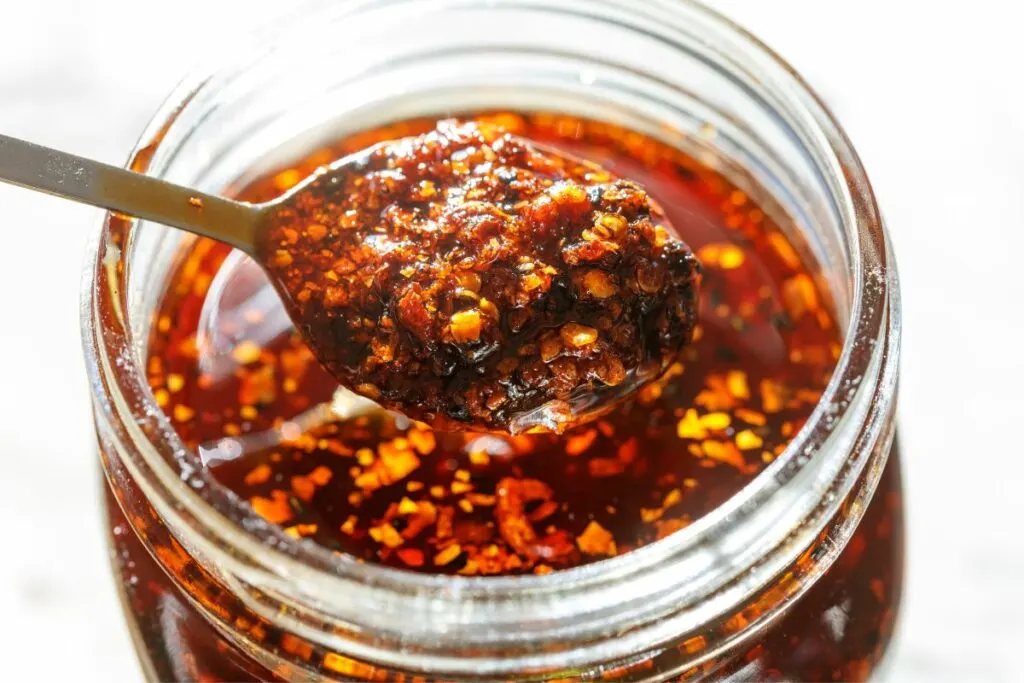
Harissa Paste
1 teaspoon of gochujang = 1/2 teaspoon of harissa paste
Harissa Paste is a flavorful alternative to gochujang. It’s a blend of chili peppers, garlic, coriander, cumin, and other spices. This gives it a unique smoky, spicy, and rich flavor profile that’s perfect for marinades, sauces, and a rub for grilled meats. If you can’t find this sauce, you can use harissa paste substitutes for a similar, if not better, flavor swap.
🧐 FAQs
Gochujang can be found in most Asian grocery stores and some mainstream grocery stores. It’s also available online on websites like Amazon, Walmart, and Korean specialty stores.
Gochujang has a long shelf life, but it does expire. The expiration date is usually printed on the package. Once opened, gochujang can be stored in the refrigerator for up to a year.
The paste has a deep, earthy umami flavor that is derived from the fermentation process. It is also slightly sweet and tangy with a distinct spicy kick. The level of spiciness can vary depending on the brand and the type of chili pepper used.
Gochujang is pronounced as “go-choo-jang” with a hard “g” sound. The “j” is pronounced like the “j” in “jelly.”
